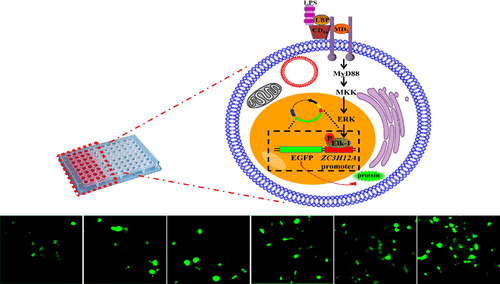当前位置:
X-MOL 学术
›
J. Agric. Food Chem.
›
论文详情
Our official English website, www.x-mol.net, welcomes your
feedback! (Note: you will need to create a separate account there.)
Cell Based-Green Fluorescent Biosensor Using Cytotoxic Pathway for Bacterial Lipopolysaccharide Recognition
Journal of Agricultural and Food Chemistry ( IF 5.7 ) Pub Date : 2018-06-15 00:00:00 , DOI: 10.1021/acs.jafc.8b01542 Jiadi Sun 1 , Pei Zhu 2 , Xiumei Wang 1 , Jian Ji 1 , Jean de Dieu Habimana 1 , Jingdong Shao 3 , Hongtao Lei 4 , Yinzhi Zhang 1 , Xiulan Sun 1
Journal of Agricultural and Food Chemistry ( IF 5.7 ) Pub Date : 2018-06-15 00:00:00 , DOI: 10.1021/acs.jafc.8b01542 Jiadi Sun 1 , Pei Zhu 2 , Xiumei Wang 1 , Jian Ji 1 , Jean de Dieu Habimana 1 , Jingdong Shao 3 , Hongtao Lei 4 , Yinzhi Zhang 1 , Xiulan Sun 1
Affiliation

|
Lipopolysaccharide (LPS), a characteristic component of the outer membrane of Gram-negative bacteria, can be used as an effective biomarker to detect bacterial contamination. Here, we reported a 293/hTLR4A-MD2-CD14 cell-based fluorescent biosensor to detect and identify LPS, which is carried out in a 96-well microplate which is nondestructive, user-friendly, and highly efficient. The promoter sequence of the critical signaling pathway gene ZC3H12A (encoding MCPIP1 protein) and enhanced green fluorescence protein (EGFP) were combined to construct a recombinant plasmid, which was transferred into 293/hTLR4A-MD2-CD14 cells through lipid-mediated, DNA-transfection way. LPS was able to bind to TLR4 and coreceptors-induced signaling pathway could result in green fluorescent protein expression. Results show that stable transfected 293/hTLR4A-MD2-CD14 cells with LPS treatment could be directly and continually observed under a high content screening imaging system. The novel cell-based biosensor detects LPS at low concentration, along with the detection limit of 0.075 μg/mL. The cell-based biosensor was evaluated by differentiating Gram-negative and Gram-positive bacteria and detecting LPS in fruit juices as well. This proposed fluorescent biosensor has potential in sensing LPS optically in foodstuff and biological products, as well as bacteria identification, contributing to the control of foodborne diseases and ensurance of public food safety with its high throughput detection way.
中文翻译:

基于细胞的绿色荧光生物传感器,通过细胞毒性途径用于细菌脂多糖的识别
脂多糖(LPS)是革兰氏阴性细菌外膜的特征成分,可以用作检测细菌污染的有效生物标志物。在这里,我们报告了一种基于293 / hTLR4A-MD2-CD14细胞的荧光生物传感器,用于检测和识别LPS,该传感器在96孔微孔板中进行,该孔无损,用户友好且高效。关键信号通路基因ZC3H12A的启动子序列分别将编码MCPIP1蛋白(MCPIP1蛋白)和增强型绿色荧光蛋白(EGFP)的重组质粒构建,通过脂质介导的DNA转染方法将其转移到293 / hTLR4A-MD2-CD14细胞中。LPS能够与TLR4结合,并且共受体诱导的信号传导途径可能导致绿色荧光蛋白表达。结果表明,在高含量筛选成像系统下,可以直接和连续观察到经LPS处理的稳定转染的293 / hTLR4A-MD2-CD14细胞。新型的基于细胞的生物传感器可检测低浓度的LPS,检测限为0.075μg/ mL。通过区分革兰氏阴性菌和革兰氏阳性菌并检测果汁中的LPS来评估基于细胞的生物传感器。
更新日期:2018-06-15
中文翻译:

基于细胞的绿色荧光生物传感器,通过细胞毒性途径用于细菌脂多糖的识别
脂多糖(LPS)是革兰氏阴性细菌外膜的特征成分,可以用作检测细菌污染的有效生物标志物。在这里,我们报告了一种基于293 / hTLR4A-MD2-CD14细胞的荧光生物传感器,用于检测和识别LPS,该传感器在96孔微孔板中进行,该孔无损,用户友好且高效。关键信号通路基因ZC3H12A的启动子序列分别将编码MCPIP1蛋白(MCPIP1蛋白)和增强型绿色荧光蛋白(EGFP)的重组质粒构建,通过脂质介导的DNA转染方法将其转移到293 / hTLR4A-MD2-CD14细胞中。LPS能够与TLR4结合,并且共受体诱导的信号传导途径可能导致绿色荧光蛋白表达。结果表明,在高含量筛选成像系统下,可以直接和连续观察到经LPS处理的稳定转染的293 / hTLR4A-MD2-CD14细胞。新型的基于细胞的生物传感器可检测低浓度的LPS,检测限为0.075μg/ mL。通过区分革兰氏阴性菌和革兰氏阳性菌并检测果汁中的LPS来评估基于细胞的生物传感器。











































 京公网安备 11010802027423号
京公网安备 11010802027423号